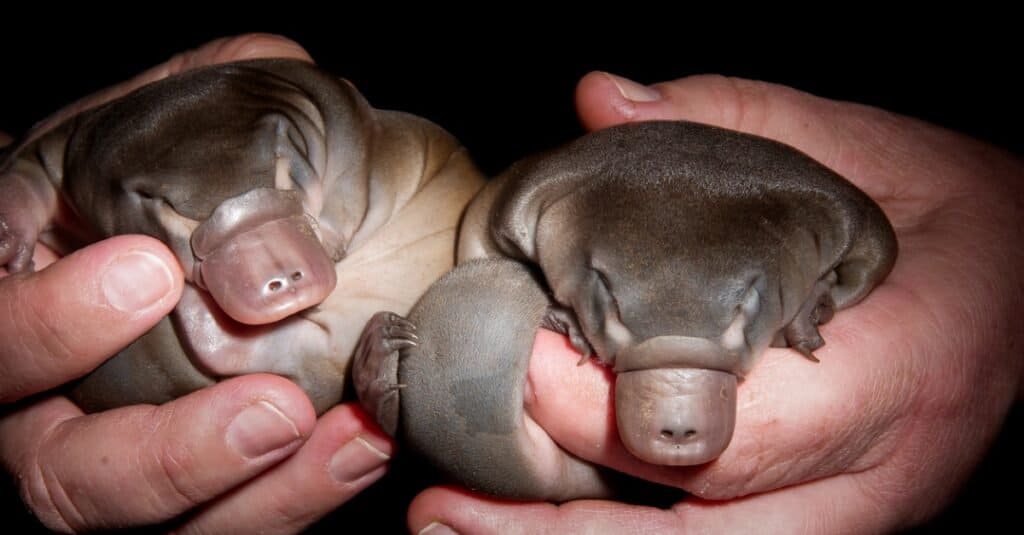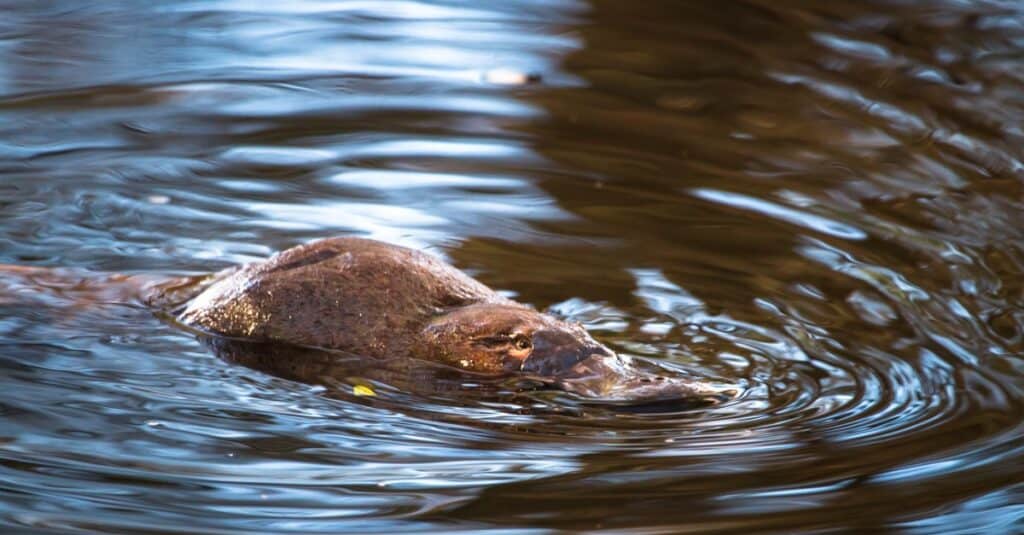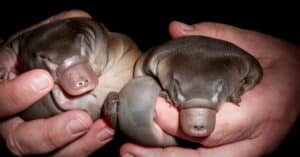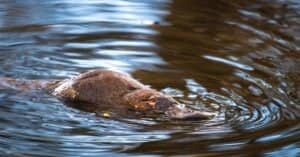Platypuses (Ornithorhynchus anatinus) are endemic Australian animals that are icons of the continent. They are often depicted as cute animals on merchandise like stuffed animals or posters, but are they cute and cuddly in real life? Do platypuses make good pets?
What Is a Platypus?

Endemic to Australia, platypuses are unique mammals with duck-like bills that lay eggs.
©John Carnemolla/Shutterstock.com
A platypus is an egg-laying mammal endemic to Australia. It’s furry with a leathermade duckbill, and it often lives up to 20 years in the wild.
They have a tail that resembles that of a beaver, and they have otter-like feet, which they use to swim adeptly. They also have a bio-fluorescent quality to their fur coats, a newly discovered trait they share with other mammals like American opossums.
Platypuses are monotremes, which means they’re mammals that lay eggs and secrete milk through pores rather than deliver it through a nipple, udder, or teat of some kind. They’re related to four other species of echidnas, though platypuses are unique. They’re an ancient species that likely still lay eggs because of the influence of their reptilian ancestors from millions of years ago.
Platypuses are smaller than most people realize. The largest comes in at a max of less than 3 feet in length, and they usually average no more than 7 pounds in weight. Generally, platypuses are about 50 percent of the size of a domesticated cat.
Is It Legal to Own a Platypus?
It is illegal to own a platypus anywhere in the world. Australia labels them as a protected species, and they cannot be owned, bred, sold, or traded within the country or for export. Only licensed wildlife professionals in Australia can come into ownership of a platypus temporarily if the animal needs some kind of rehabilitation.
Do Platypuses Make Good Pets?

Platypuses not only make terrible pets, but they’re also illegal to own anywhere in the world.
©iStock.com/IainStych
No, platypuses do not make good pets. Platypuses are not domesticated animals. This means that even if they are somehow tamed, they will never be a good pet.
Platypuses require huge habitats, and they have complex eating habits that are hard to replicate in any kind of enclosure. Even under the best professional circumstances at zoos, keeping a platypus in captivity is extremely difficult.
Hundreds have died over the last century as institutions tried to take ownership of these animals. Today, there are two platypuses at the San Diego Zoo Safari Park in Southern California and less than a dozen organizations in Australia with platypuses.
Discover the Personality of a Platypus
Platypuses are wild animals, and under no circumstances do they act like domesticated pets. They do not enjoy being handled, nor do they tolerate being petted or snuggled. If you happen to see one in the wild, which is rare, leave the platypus alone.
However, a platypus at the Healesville Sanctuary in Victoria, Australia, is in love with cuddling. While cuddles from the public are off the table, this sanctuary offers a chance to be near platypuses and offer them food. It’s $300 per person for this experience, and all participants must be over 12 years old.
Are Platypuses Venomous?

Male platypuses are venomous around mating season.
©iStock.com/slowmotiongli
Yes, male platypuses are venomous via a spur sitting above their rear heels. A platypus won’t kill an adult, but they can be deadly to smaller animals and potentially to little children.
While no people have officially died from platypus venom, it still causes a lot of pain that can linger for years. Anecdotal reports state that drugs like morphine do nothing to alleviate the pain.
Their venom is produced in glands connected to the male’s heel spurs around mating season. This is probably so the platypus can protect itself from competition or larger predators as it looks for a mate. Since platypus venom isn’t necrotizing like some reptilian venoms, scientists think it isn’t meant for use on prey.
Platypus Habitat and Diet

Platypuses like murky freshwater habitats like inland rivers and wetlands.
©iStock.com/Kevin Wells
In nature, platypuses live in murky freshwater habitats and use echolocation along with their bills to feel around when hunting at night. They’re semi-aquatic, and they choose to spend most of their time in the water. That’s what allows them to find their prey since the water they swim in requires their ears and eyes to remain shut.
They eat aquatic macroinvertebrates like crayfish, worms, snails, and nymphal or larval insects. While platypuses are small animals, they eat between twenty to fifty percent of their body weight every day. It takes a lot of food to sustain them.
They live in various freshwater habitats, but they have their ideal hangout spots. They’re mostly found in wetlands, inland rivers, brackish water estuaries, and billabongs.
They are burrowers, so somewhere that allows for platypus construction is ideal. Shallower waters provide easier access to food as the platypuses can easily reach the bottom to find prey.
They like shorelines with trees, tall grass, or shrubbery. That’s because they like to come out of the water and hide in logs or near rocks. All of their breeding and most of their resting takes place on land.
The photo featured at the top of this post is © John Carnemolla/Shutterstock.com
Thank you for reading! Have some feedback for us? Contact the AZ Animals editorial team.





